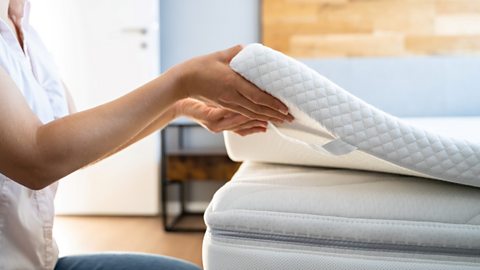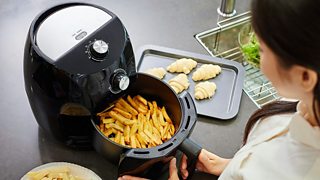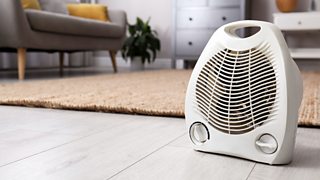What type of mattress gives you the best night's sleep?
We spend, on average, around a third of our lives asleep. A good mattress is, therefore, a sound investment, but choosing one is not a decision you can just sleepwalk into. What gives you the best night's sleep? Springs? Foam? A hybrid of the two? Does whether you sleep on your side or your back affect your decision? Does price matter? And can any of them help to relieve back pain?
For ����ý Radio 4's Sliced Bread, host Greg Foot looked into these questions on behalf of Stephen, a listener who suffers from back pain and is thinking about changing his current pocket sprung mattress for a memory foam one. Greg enlists the help of Simon Williams from the National Bed Federation and Dr Renata Rhia, a consultant in Sleep and Respiratory Medicine at the University of Edinburgh, to put this mattress conundrum to rest.
1. The amount of choice isn't something you should lose sleep over
The two basic classifications of mattress are sprung and non-sprung, but they have various sub-groups. Sprung mattresses break down into: open coil springs (coils of high tensile steel, wound into hundreds of springs and connected by a wire rod edge); continuous coil springs (formed from a single piece of wire that runs continuously from side to side across a mattress) and pocket springs (each one in its own individual fabric pocket). Meanwhile, non-sprung mattresses are usually foam, either standard foam, latex foam or memory foam.
A hybrid mattress takes the best of spring technology and foam technology, puts them together and hey presto!Simon Williams, National Bed Federation
2. Hybrid mattresses offer 'the best of both worlds'
If you weren't already spoiled for choice, there's also a hybrid mattress option. Hybrid mattresses are formed from different combinations of all of the above.
These are often very expensive, with one example, given by Greg, comprising of more than 14,000 mini pocket springs and five layers of foam, that retails for £1,300. However, many of the "bed in a box" products are hybrids offered at a mid-market price point.
Simon Williams from the National Bed Federation is certainly a fan. "You could say hybrid is the best of all worlds when it comes to mattresses," he says. "You take the best of the spring technology and take the best of the foam technology, and put them together and hey presto!"
3. But coil spring mattresses are the cheapest
If cost is your number one concern, then open or continuous coil mattresses are the cheapest options. They are also lighter to move!
However, neither of these types of mattress offer independent support, meaning that when one person moves their partner will feel that motion. Pocket sprung mattresses do offer independent support and Simon Williams says that, when it comes to coil mattresses, "it is generally accepted within the industry that a pocket sprung mattress is a better quality." This is true both in terms of support and of longevity.

4. Some mattresses have 20,000 springs
Greg says he's seen mattresses on sale with anything from 400 to 2,000 springs, and wondered if size matters.
For pocket sprung mattresses, anything with less than 800 springs in a king-sized mattress wouldn’t offer sufficient support.Simon Williams, National Bed Federation
It certainly seems to have some bearing. Simon advises that, for pocket sprung mattresses, anything less than 800 springs in a king-sized mattress wouldn’t offer sufficient support.
There are also mattresses with between 15 and 20,000 springs in them. These are 'mini springs' and used in layers for extra comfort.
5. In most cases, you don't need to turn your mattress over
With technological advances in springs and fillings, most sprung and foam mattresses are now designed as a single-sided sleeping surface.
The most notable exceptions are the higher-end pocket sprung mattresses. These have identical layers of fillings on both sides that pack down when they are slept on, particularly underneath the heavier body areas of the shoulder and posterior. Flipping the mattress over allows gravity to take its course and recover the fillings so that side can be slept on again later.
6. Memory foam is 'the marmite of the bed industry'
Memory foam is a step up from the cheaper standard polyurethane foam, itself a supportive and long-lasting material. Memory foam is also 'viscoelastic', with additives in it that react slowly to bodyweight and body heat, gradually moulding itself to the sleeper before then – the 'memory' part – slowly reforming to its original shape when they move.
Simon calls memory foam "the marmite of the bed industry" because people who move a lot in their sleep will be more aware of the indentations in the bed and there are some people, such as listener Stephen, who find their memory foam mattress too warm.
Though heat is harder to escape in a mattress that moulds around the body, Simon says the foam used now is more breathable and temperature-regulating.

Does mattress price matter?
Greg Foot talks to Simon Williams from the National Bed Federation about mattress brands.
7. Tempur memory foam was originally designed for astronauts
One of the most expensive brands of mattress is Tempur, with Greg quoting top-line prices of around £3,500. Their origin story, perhaps part of the price tag, comes from the original use of the Tempur material for cushioning astronauts and then for pressure relief in hospitals.
If the mattress is too firm, it doesn't let your shoulders and your neck sink into it. Too soft and you can get problems with your hips and shoulders.Dr Renata Rhia
The commercial side happened later but the ingredients and engineering that go into Tempur mattresses have remained an industry secret and one that, the company maintains, only a handful of highly-trained scientists know. As Simon points out, it's very similar to a Coca Cola situation. While acknowledging the unique feel of a Tempur mattress, he adds: "there are other brands of cola."
8. The right mattress for your back pain is medium firm
Back pain is reportedly the largest single cause of disability in the UK, with lower back pain accounting for 11% of the total disability of the UK population. So, for a back pain sufferer like listener Stephen, picking the right mattress is a decision with an extra layer of importance.
Studies have found that a medium firm mattress is the best option. "If the mattress is too firm, it doesn't let your shoulders and your neck sink into it," explains Dr Renata Rhia, consultant in Sleep and Respiratory Medicine at the University of Edinburgh, "and if it's way too soft, you can get problems with your hips and shoulders because they sink too far into the mattress."
9. Any manufacturer can claim a mattress is orthopaedic
Dr Rhia says that "sometimes just changing a mattress can make a difference." Certainly, an old, sagging mattresses should get the boot, and there's a generally accepted wisdom, echoed by Simon Williams, that mattresses should be changed every seven years anyway, given how much body moisture and sweat they will absorb.
If, on your search, you're tempted by the description of a mattress as 'orthopaedic', then you should think again. The use of the term is unrestricted and "can be applied by the manufacturer irrespective of whether it is truly designed to help with orthopaedic problems or not," Dr Rhia says.
10. Your sleeping position could dictate what mattress type is for you
If, like listener Stephen, you're going to choose a mattress to help with back pain, then your next choice is whether it is sprung or non-sprung.
Simon says that memory foam has had "a major impact on the mattress market in the last 20-25 years and is a very, very well-respected product," so, perhaps, despite listener Stephen's misgivings about the warmth of his memory foam mattress, he might be tempted to stick with it? But there's also the hybrid option that Simon has described as "the best of both worlds."
There's another twist, though. Summing up her findings for Greg, Dr Riha says "if Stephen lies mainly on his side, memory foam might be useful. If he mainly sleeps on his back or prone, then I would probably suggest investing in a coil-spring mattress."
You can hear more of Greg's findings, and find out whether Stephen gets his dream mattress, by listening here.
The information contained in this article was correct at the time of broadcast on 2 March, 2023.

More articles from Radio 4
-
![]()
5 tips to help improve your sleep
Michael Mosley takes an audio deep-dive inside the body's sleep mechanisms.
-
![]()
Can SAD lamps and wake-up lights help boost your mood?
Greg Foot speaks to experts in light therapy.
-
![]()
Are these 'must-have' gadgets worth buying in the sales?
From air fryers to massage guns, Greg Foot examines trending wonder products.
-
![]()
What's the best way to heat a room this winter?
Greg Foot gets cosy with portable home heating options – or space heaters.





